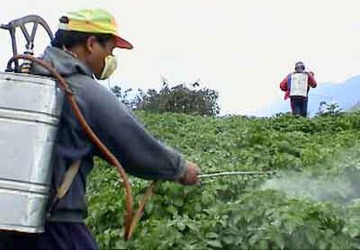Pesticides: a silent killer?
by Dushani Palliyaguru
A pesticide is defined as any substance or mixture of substances used
to prevent, destroy, repel, ormitigate any pest. These include
insecticides (affects insects), herbicides (affects plants and weeds)and
fungicides (affects fungi). The main advantage in using pesticides is
its ability to produce a highyield in crops. Adding to this trend, in
the recent past, genetically modified crops (GMCs) have beendeveloped to
produce an even better yield. No one can deny the uses of pesticides for
protection ofcrops in the field, thereby providing us with abundant,
inexpensive and attractive fruits andvegetables. Yet, there is no such
thing as a completely safe pesticide; its purpose is to kill and
thequestion is who?
 When DDT (dichloro-diphenyl-trichloroethane) was introduced in the
1940's, it marked the beginningof a revolution. When DDT (dichloro-diphenyl-trichloroethane) was introduced in the
1940's, it marked the beginningof a revolution.
It was used to control malaria, typhus, and other insect-borne
diseases. However, asa result of overuse, many insect pest species
developed resistance to DDT. Increasing concerns overhealth effects in
humans and wildlife, and lessened effectiveness lead to DDT being banned
in manycountries. Since the introduction of DDT, thousands of new
chemicals have entered the market aspesticides, out of which many have
been proven to have more risks than benefits.
Contrary to popular belief, it is not only farmers and individuals
who work closely with pesticides thatare exclusively victims of
pesticide exposure. In addition to accidental, suicidal and
occupationalexposures (during manufacturing, mixing, loading and
harvesting), bystanders can also be exposedas a result of off-target
drift from spraying operations. Moreover, members of the general public
who consume food items containing pesticide residues also ultimately
fall prey to their unpleasant effects.
It has been thought that the biological effects are most lethal and
immediate for accidental andsuicidal poisonings while they are the least
for the general population that consumes pesticide-contaminated food.
However, over an average person's lifespan, chronic (long-term)
exposure to agiven pesticide or several pesticides can have many adverse
health effects, even if they areconsumed in minor amounts.
Extensive studies have been carried out to determine the associations
between exposure topesticides and human disease.
While overdose of many pesticides can result in immediate death,
aswith the case of pesticides used for suicides, pesticide toxicity in
low doses over a long period of timecan also result in conditions such
as organ failure, cancer and diabetes.
The risk for developing theseconditions has also been observed to be
much higher amongst occupational users of pesticides, such as farmers.
All pesticides are manufactured as mixtures of several chemicals and
most of these individual chemicals have been shown to affect human
health.
For example, the heavy metal cadmium, which is found commonly in
fungicides and is also added to fertilizers, is known to be associated
with the induction of chronic renal tubular disease and other
kidney-related dysfunctions.
Interestingly enough, cadmium has been shown to be one of the
possible causative agents of chronic kidney disease with unknown
etiology, a disease that is also most prevalent amongst farmers in the
North-Eastern region of Sri Lanka.
Cadmium and other heavy metals, such as arsenic, and mercury are not
the only culprits.
Organochlorine insecticides such as DDT have been shown to directly
and indirectly interfere with fertility and reproduction in both
wildlife and laboratory species of animals.
While organochlorine insecticides are being banned from the markets
of developed countries, developing countries continue to use them
because they are relatively inexpensive to manufacture, highly effective
and the absence of substitutes.
Sri Lanka banned its last approved organochlorine pesticide,
chlordane in 1996.
However, the Sri Lankan pesticide market still carries a variety of
chemicals, including but not limited to organophosphates (insecticide)
and dithiocarbamates (fungicide). Organophosphate toxicity has been
associated with psychological and neurological disorders while
dithiocarbamates have been shown to have adverse reproductive outcomes
in pregnancy rate and fetal development.
One of the biggest challenges here is the absence of sufficient data
to determine associations and causality between pesticide exposure and
long-term health effects. This lack of information is often exploited by
agrochemical manufactures to market products that have not been amply
studied for safety, especially to developing countries.
As mentioned previously, the use of pesticides has given man several
advantages for agriculture andcrop management. Nevertheless, one cannot
ignore the health hazard they can cause when abusedand used under
improper guidelines. Despite the recent development of second-and third-generationderivatives
of the early chemical pesticides, all pesticides possess an inherent
degree of toxicity tosome living organism, otherwise they would be of no
practical use. For farmers, emphasizing on simple handling techniques
such as wearing protective masks, gloves and footwear when working in
the fields, during spraying can mitigate a large proportion of the
occupational exposure to pesticides.
It is important that manufactures present the minimum volume of
pesticide that can be sprayed in order to obtain the highest yield,
which could minimize exposures to toxic agents. An article that was
published in The Lancet in 2002, Michael Eddleston and colleagues
proposed introducing "a minimum pesticide list" as a measure to lessen
pesticide-related suicides in developing countries. An effort of that
nature could also be potentially useful to regulate pesticide imports
and distribution.
Furthermore, continuing research to study the adverse health effects
of pesticides that are currently in the market, imposing strict
regulatory standards for those chemicals that have been shown to be
associated with health conditions and using alternative pest control
methods such as integrated pest management (IPM) can have a
long-standing positive impact for safe food for generations to come.
Dushani Palliyaguru is a doctoral student at the Department of
Environmental and Occupational Health, University of Pittsburgh, USA. |

